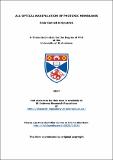All-optical manipulation of photonic membranes
Abstract
Optical tweezers have allowed us to harness the momentum of light to trap, move, and
manipulate microscopic particles with Angstrom-level precision. Position and force feedback
systems grant us the ability to feel the microscopic world. As a tool, optical tweezers have allowed
us to study a variety of biological systems, from the mechanical properties of red blood cells to the
quantised motion of motor-molecules such as kinesin. They have been applied, with similar impact,
to the manipulation of gases, atoms, and Bose-Einstein condensates. There are, however, limits to
their applicability. Historically speaking, optical tweezers have only been used to trap relatively
simple structures such as spheres or cylinders.
This thesis is concerned with the development of a fabricational and optical manipulation
protocol that allows holographical optical tweezers to trap photonic membranes. Photonic membranes
are thin, flexible membranes, that are capable of supporting nanoplasmonic features. These
features can be patterned to function as metamaterials, granting the photonic membrane the ability
to function as almost any optical device. It is highly desirable to take advantage of these tools in a
microfluidic environment, however, their extreme aspect ratios mean that they are not traditionally
compatible with the primary technology of microfluidic manipulation: optical tweezers.
In line with recent developments in optical manipulation, an holistic approach to optical
trapping is used to overcome these limitations. Full six-degree-of-freedom control over a photonic
membrane is demonstrated through the use of holographical optical tweezers. Furthermore,
a photonic membrane (PM)-based surface-enhanced Raman spectroscopy sensor is presented
which is capable of detecting rhodamine dye from a topologically undulating sample. This work
moves towards marrying these technologies such that photonic membranes, designed for bespoke
applications, can be readily deployed into a microfluidic environment. Extending the range of tools
available in the microfluidic setting helps pave the way toward the next set of advances in the field
of optical manipulation.
Type
Thesis, PhD Doctor of Philosophy
Collections
Items in the St Andrews Research Repository are protected by copyright, with all rights reserved, unless otherwise indicated.

